Yun Sing Koh
MultiPhishGuard: An LLM-based Multi-Agent System for Phishing Email Detection
May 26, 2025Abstract:Phishing email detection faces critical challenges from evolving adversarial tactics and heterogeneous attack patterns. Traditional detection methods, such as rule-based filters and denylists, often struggle to keep pace with these evolving tactics, leading to false negatives and compromised security. While machine learning approaches have improved detection accuracy, they still face challenges adapting to novel phishing strategies. We present MultiPhishGuard, a dynamic LLM-based multi-agent detection system that synergizes specialized expertise with adversarial-aware reinforcement learning. Our framework employs five cooperative agents (text, URL, metadata, explanation simplifier, and adversarial agents) with automatically adjusted decision weights powered by a Proximal Policy Optimization reinforcement learning algorithm. To address emerging threats, we introduce an adversarial training loop featuring an adversarial agent that generates subtle context-aware email variants, creating a self-improving defense ecosystem and enhancing system robustness. Experimental evaluations on public datasets demonstrate that MultiPhishGuard significantly outperforms Chain-of-Thoughts, single-agent baselines and state-of-the-art detectors, as validated by ablation studies and comparative analyses. Experiments demonstrate that MultiPhishGuard achieves high accuracy (97.89\%) with low false positive (2.73\%) and false negative rates (0.20\%). Additionally, we incorporate an explanation simplifier agent, which provides users with clear and easily understandable explanations for why an email is classified as phishing or legitimate. This work advances phishing defense through dynamic multi-agent collaboration and generative adversarial resilience.
Reducing Smoothness with Expressive Memory Enhanced Hierarchical Graph Neural Networks
Apr 02, 2025Abstract:Graphical forecasting models learn the structure of time series data via projecting onto a graph, with recent techniques capturing spatial-temporal associations between variables via edge weights. Hierarchical variants offer a distinct advantage by analysing the time series across multiple resolutions, making them particularly effective in tasks like global weather forecasting, where low-resolution variable interactions are significant. A critical challenge in hierarchical models is information loss during forward or backward passes through the hierarchy. We propose the Hierarchical Graph Flow (HiGFlow) network, which introduces a memory buffer variable of dynamic size to store previously seen information across variable resolutions. We theoretically show two key results: HiGFlow reduces smoothness when mapping onto new feature spaces in the hierarchy and non-strictly enhances the utility of message-passing by improving Weisfeiler-Lehman (WL) expressivity. Empirical results demonstrate that HiGFlow outperforms state-of-the-art baselines, including transformer models, by at least an average of 6.1% in MAE and 6.2% in RMSE. Code is available at https://github.com/TB862/ HiGFlow.git.
A Study on Monthly Marine Heatwave Forecasts in New Zealand: An Investigation of Imbalanced Regression Loss Functions with Neural Network Models
Feb 19, 2025Abstract:Marine heatwaves (MHWs) are extreme ocean-temperature events with significant impacts on marine ecosystems and related industries. Accurate forecasts (one to six months ahead) of MHWs would aid in mitigating these impacts. However, forecasting MHWs presents a challenging imbalanced regression task due to the rarity of extreme temperature anomalies in comparison to more frequent moderate conditions. In this study, we examine monthly MHW forecasts for 12 locations around New Zealand. We use a fully-connected neural network and compare standard and specialized regression loss functions, including the mean squared error (MSE), the mean absolute error (MAE), the Huber, the weighted MSE, the focal-R, the balanced MSE, and a proposed scaling-weighted MSE. Results show that (i) short lead times (one month) are considerably more predictable than three- and six-month leads, (ii) models trained with the standard MSE or MAE losses excel at forecasting average conditions but struggle to capture extremes, and (iii) specialized loss functions such as the balanced MSE and our scaling-weighted MSE substantially improve forecasting of MHW and suspected MHW events. These findings underscore the importance of tailored loss functions for imbalanced regression, particularly in forecasting rare but impactful events such as MHWs.
CapyMOA: Efficient Machine Learning for Data Streams in Python
Feb 11, 2025Abstract:CapyMOA is an open-source library designed for efficient machine learning on streaming data. It provides a structured framework for real-time learning and evaluation, featuring a flexible data representation. CapyMOA includes an extensible architecture that allows integration with external frameworks such as MOA and PyTorch, facilitating hybrid learning approaches that combine traditional online algorithms with deep learning techniques. By emphasizing adaptability, scalability, and usability, CapyMOA allows researchers and practitioners to tackle dynamic learning challenges across various domains.
Diving Deep: Forecasting Sea Surface Temperatures and Anomalies
Jan 10, 2025Abstract:This overview paper details the findings from the Diving Deep: Forecasting Sea Surface Temperatures and Anomalies Challenge at the European Conference on Machine Learning and Principles and Practice of Knowledge Discovery in Databases (ECML PKDD) 2024. The challenge focused on the data-driven predictability of global sea surface temperatures (SSTs), a key factor in climate forecasting, ecosystem management, fisheries management, and climate change monitoring. The challenge involved forecasting SST anomalies (SSTAs) three months in advance using historical data and included a special task of predicting SSTAs nine months ahead for the Baltic Sea. Participants utilized various machine learning approaches to tackle the task, leveraging data from ERA5. This paper discusses the methodologies employed, the results obtained, and the lessons learned, offering insights into the future of climate-related predictive modeling.
Higher Order Graph Attention Probabilistic Walk Networks
Nov 18, 2024Abstract:Graphs inherently capture dependencies between nodes or variables through their topological structure, with paths between any two nodes indicating a sequential dependency on the nodes traversed. Message Passing Neural Networks (MPNNs) leverage these latent relationships embedded in graph structures, and have become widely adopted across diverse applications. However, many existing methods predominantly rely on local information within the $1$-hop neighborhood. This approach has notable limitations; for example, $1$-hop aggregation schemes inherently lose long-distance information, and are limited in expressive power as defined by the $k$-Weisfeiler-Leman ($k$-WL) isomorphism test. To address these issues, we propose the Higher Order Graphical Attention (HoGA) module, which assigns weights to variable-length paths sampled based on feature-vector diversity, effectively reconstructing the $k$-hop neighborhood. HoGA represents higher-order relationships as a robust form of self-attention, applicable to any single-hop attention mechanism. In empirical studies, applying HoGA to existing attention-based models consistently leads to significant accuracy improvements on benchmark node classification datasets. Furthermore, we observe that the performance degradation typically associated with additional message-passing steps may be mitigated.
An Individual Identity-Driven Framework for Animal Re-Identification
Oct 30, 2024


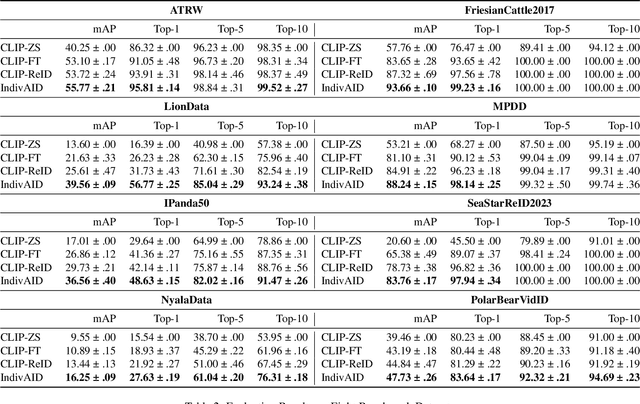
Abstract:Reliable re-identification of individuals within large wildlife populations is crucial for biological studies, ecological research, and wildlife conservation. Classic computer vision techniques offer a promising direction for Animal Re-identification (Animal ReID), but their backbones' close-set nature limits their applicability and generalizability. Despite the demonstrated effectiveness of vision-language models like CLIP in re-identifying persons and vehicles, their application to Animal ReID remains limited due to unique challenges, such as the various visual representations of animals, including variations in poses and forms. To address these limitations, we leverage CLIP's cross-modal capabilities to introduce a two-stage framework, the \textbf{Indiv}idual \textbf{A}nimal \textbf{ID}entity-Driven (IndivAID) framework, specifically designed for Animal ReID. In the first stage, IndivAID trains a text description generator by extracting individual semantic information from each image, generating both image-specific and individual-specific textual descriptions that fully capture the diverse visual concepts of each individual across animal images. In the second stage, IndivAID refines its learning of visual concepts by dynamically incorporating individual-specific textual descriptions with an integrated attention module to further highlight discriminative features of individuals for Animal ReID. Evaluation against state-of-the-art methods across eight benchmark datasets and a real-world Stoat dataset demonstrates IndivAID's effectiveness and applicability. Code is available at \url{https://github.com/ywu840/IndivAID}.
Enabling Asymmetric Knowledge Transfer in Multi-Task Learning with Self-Auxiliaries
Oct 21, 2024Abstract:Knowledge transfer in multi-task learning is typically viewed as a dichotomy; positive transfer, which improves the performance of all tasks, or negative transfer, which hinders the performance of all tasks. In this paper, we investigate the understudied problem of asymmetric task relationships, where knowledge transfer aids the learning of certain tasks while hindering the learning of others. We propose an optimisation strategy that includes additional cloned tasks named self-auxiliaries into the learning process to flexibly transfer knowledge between tasks asymmetrically. Our method can exploit asymmetric task relationships, benefiting from the positive transfer component while avoiding the negative transfer component. We demonstrate that asymmetric knowledge transfer provides substantial improvements in performance compared to existing multi-task optimisation strategies on benchmark computer vision problems.
A Probabilistic Framework for Adapting to Changing and Recurring Concepts in Data Streams
Aug 18, 2024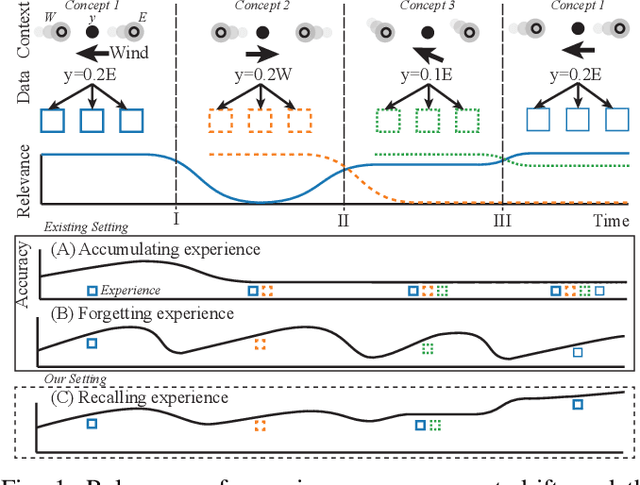


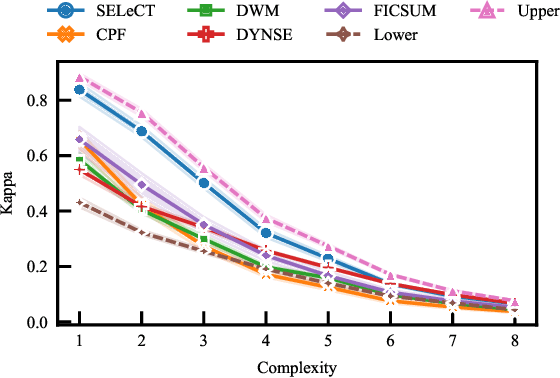
Abstract:The distribution of streaming data often changes over time as conditions change, a phenomenon known as concept drift. Only a subset of previous experience, collected in similar conditions, is relevant to learning an accurate classifier for current data. Learning from irrelevant experience describing a different concept can degrade performance. A system learning from streaming data must identify which recent experience is irrelevant when conditions change and which past experience is relevant when concepts reoccur, \textit{e.g.,} when weather events or financial patterns repeat. Existing streaming approaches either do not consider experience to change in relevance over time and thus cannot handle concept drift, or only consider the recency of experience and thus cannot handle recurring concepts, or only sparsely evaluate relevance and thus fail when concept drift is missed. To enable learning in changing conditions, we propose SELeCT, a probabilistic method for continuously evaluating the relevance of past experience. SELeCT maintains a distinct internal state for each concept, representing relevant experience with a unique classifier. We propose a Bayesian algorithm for estimating state relevance, combining the likelihood of drawing recent observations from a given state with a transition pattern prior based on the system's current state.
Privacy-Preserving Low-Rank Adaptation for Latent Diffusion Models
Feb 19, 2024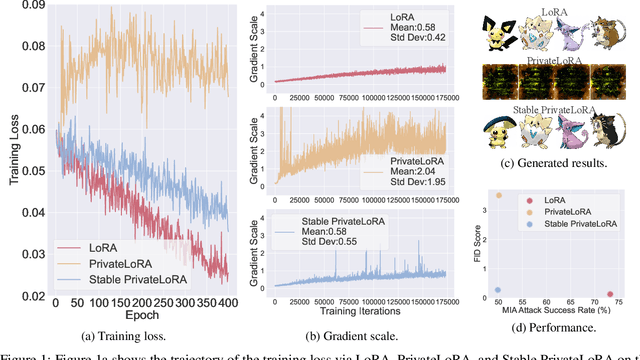
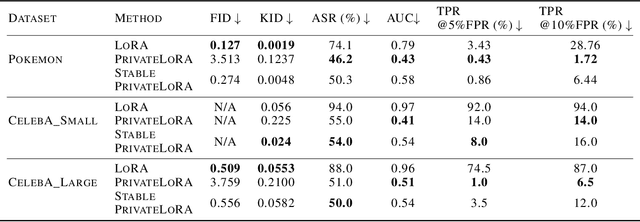
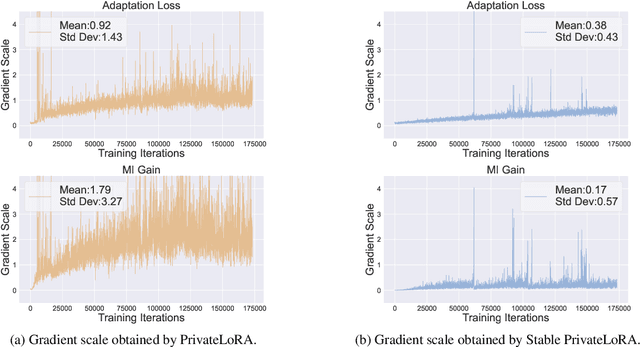
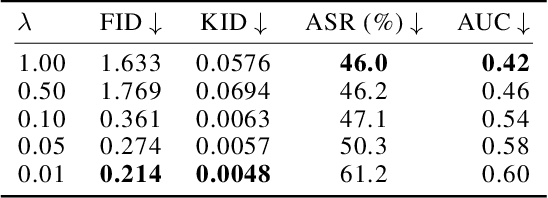
Abstract:Low-rank adaptation (LoRA) is an efficient strategy for adapting latent diffusion models (LDMs) on a training dataset to generate specific objects by minimizing the adaptation loss. However, adapted LDMs via LoRA are vulnerable to membership inference (MI) attacks that can judge whether a particular data point belongs to private training datasets, thus facing severe risks of privacy leakage. To defend against MI attacks, we make the first effort to propose a straightforward solution: privacy-preserving LoRA (PrivateLoRA). PrivateLoRA is formulated as a min-max optimization problem where a proxy attack model is trained by maximizing its MI gain while the LDM is adapted by minimizing the sum of the adaptation loss and the proxy attack model's MI gain. However, we empirically disclose that PrivateLoRA has the issue of unstable optimization due to the large fluctuation of the gradient scale which impedes adaptation. To mitigate this issue, we propose Stable PrivateLoRA that adapts the LDM by minimizing the ratio of the adaptation loss to the MI gain, which implicitly rescales the gradient and thus stabilizes the optimization. Our comprehensive empirical results corroborate that adapted LDMs via Stable PrivateLoRA can effectively defend against MI attacks while generating high-quality images. Our code is available at https://github.com/WilliamLUO0/StablePrivateLoRA.
 Add to Chrome
Add to Chrome Add to Firefox
Add to Firefox Add to Edge
Add to Edge